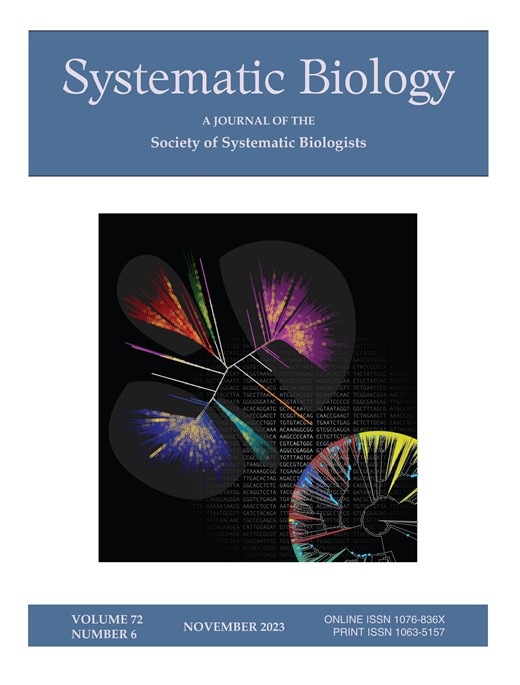系统发育支持评价的新视角:用新的相对矛盾指数研究鳄鱼的系统发育争议
IF 5.7
1区 生物学
Q1 EVOLUTIONARY BIOLOGY
引用次数: 0
摘要
自从系统发育方法出现以来,已经开发了许多工具来评估树的稳健性。识别系统发育矩阵中的矛盾程度,以及每个分类群和特征的具体贡献,对于估计其可靠性至关重要。在以简约为基础的系统发育推断中,系统发育是由分析中使用的所有特征的相互作用产生的。因此,矩阵中字符最初提供的支持可能与最终树优化后的支持不同,从而切断了矩阵的系统发育内容与最终树的系统发育内容之间的联系。因此,所有旨在测量支持度的方法都是间接的,个体性状或分类群的影响只能在分析后才能评估。3 -taxon analysis (3ta)是一种系统发育方法,可以通过直接从系统发育矩阵中精确测量目标性状和/或分类群的支持度来避免这些问题。在3ta中,字符被编码为树,并分解为三个分类单元语句(3ts)。该分析寻找最大的不矛盾的3ts集来计算最优的系统发育。因为分析是一个兼容性过程,而不是一个优化过程,所以树上的字符支持是相互独立的。这使得可以直接评估矩阵的支持度,从而对最优树的拓扑结构提供有意义的见解。此外,将字符分解为3ts可以精确量化结果中字符/分类群的影响。在这项研究中,我们将重点放在鳄鱼(近几十年来一直存在争议的主题)上,在最近发表的里约热内卢和Mannion(2021)矩阵中,我们使用3ta来衡量特定特征和/或分类群的支持度。这场冲突围绕着两个相互竞争的假说——长形和短形假说——支持长形总分支的不同位置。我们还引入了相对矛盾指数(RCI)来评估节点支持度,这是一个反映竞争分支假设之间矩阵矛盾程度的度量,范围从0.5(最大矛盾)到1(无矛盾)。我们发现,虽然长压力假说得到了最好的支持,但短压力假说对它提出了强烈的挑战(RCI = 0.62)。此外,我们发现,Tomistominae提供了61%的支持证据的长压力假说,这样,当删除,矩阵支持短压力假说。对于Longirostres假说,个体的贡献仅占总支持量的2%到7%。最后,我们表明,与Longirostres相关的字符只提供了一小部分(22%)的支持Longirostres假说。因此,我们的方法可以量化特定性状或分类群对系统发育结果的影响。这将证明对系统发育学家非常有用,特别是在处理不完整的材料,如化石时。本文章由计算机程序翻译,如有差异,请以英文原文为准。
New perspectives in phylogenetic support assessment: using the new Relative Contradiction Index to investigate the phylogenetic controversies in Crocodylia
Numerous tools have been developed since the advent of phylogenetic methods to assess tree robustness. Identifying the degree of contradiction in a phylogenetic matrix, as well as the specific contribution of each taxon and character, is essential for estimating its reliability. In parsimony-based phylogenetic inferences, classically used by paleontologists, a phylogeny results from the interaction of all the characters used in the analysis. Consequently, the support initially provided by the characters in the matrix may differ from that after after optimization in the final tree, severing the link between the phylogenetic content of the matrix and that of the final tree. Thus, all methods aimed at measuring support only do so indirectly and the impact of individual characters or taxa can only be assessed after the analysis. Three-taxon analysis (3ta) is a phylogenetic method that can circumvent these issues by precisely measuring the support of targeted characters and/or taxa directly from the phylogenetic matrix. In 3ta, characters are coded as trees and decomposed into three-taxon statements (3ts). The analysis searches for the largest set of non-contradicting 3ts to compute the optimal phylogeny. Because the analysis is a compatibility procedure, not an optimization procedure, character supports on the tree are independent from one another. This enables direct assessment of support from the matrix, providing meaningful insights into the topology of the optimal trees. Moreover, the decomposition of characters into 3ts allows for precise quantification of the impact of the characters/taxa in the results. In this study, focusing on Crocodylia (a subject of ongoing debate over recent decades), we use 3ta to measure the support of specific characters and/or taxa in the recently published matrix of Rio and Mannion (2021). This conflict revolves around two competing hypotheses – Longirostres and Brevirostres – supporting a different placement of the Gavialoidea clade. We also introduce here the Relative Contradiction Index (RCI) to evaluate node support, a metric that reflects the degree of contradiction in a matrix between competing cladistic hypotheses, ranging from 0.5 (maximum contradiction) to 1 (no contradiction). We show that although the Longirostres hypothesis is the best-supported, it is strongly challenged by the Brevirostres hypothesis (RCI = 0.62). Furthermore, we find that Tomistominae provides 61% of the supporting evidence for the Longirostres hypothesis, such that, when removed, the matrix supports the Brevirostres hypothesis. Individual tomistomines’ contributions vary only from 2% to 7% of the total support to the Longirostres hypothesis. Finally, we show that characters correlated to longirostry only provide a fraction (22%) of the total support to the Longirostres hypothesis. Thus, our method can quantify the impact of specific characters or taxa on a phylogenetic result. This should prove very useful to phylogeneticists, especially when dealing with incomplete material such as fossils.
求助全文
通过发布文献求助,成功后即可免费获取论文全文。
去求助
来源期刊

Systematic Biology
生物-进化生物学
CiteScore
13.00
自引率
7.70%
发文量
70
审稿时长
6-12 weeks
期刊介绍:
Systematic Biology is the bimonthly journal of the Society of Systematic Biologists. Papers for the journal are original contributions to the theory, principles, and methods of systematics as well as phylogeny, evolution, morphology, biogeography, paleontology, genetics, and the classification of all living things. A Points of View section offers a forum for discussion, while book reviews and announcements of general interest are also featured.
 求助内容:
求助内容: 应助结果提醒方式:
应助结果提醒方式:


